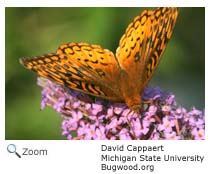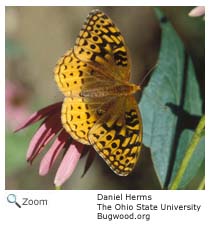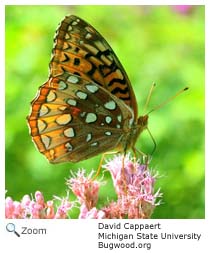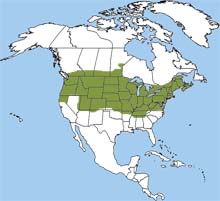Habitat
The great spangled fritillary is found in open, moist places including fields, pine and oak woods, conifer forest openings, and meadows.
Diet
 The great spangled fritillary caterpillar eats the leaves of various violet species. They eat at night. During the day, the caterpillar hides under the leaves. Adults eat the
nectar from many species of flowers including milkweeds, thistles, violets, ironweed, dogbane, mountain laurel, verbena, vetch, bergamot, red clover, joe-pye weed, and purple coneflower.
The great spangled fritillary caterpillar eats the leaves of various violet species. They eat at night. During the day, the caterpillar hides under the leaves. Adults eat the
nectar from many species of flowers including milkweeds, thistles, violets, ironweed, dogbane, mountain laurel, verbena, vetch, bergamot, red clover, joe-pye weed, and purple coneflower.
Lifecycle
 The great spangled fritillary mates in June or July. The female lays her pale brown eggs on or near violets in August and September. The caterpillars are black with orange-tipped spines. They overwinter until spring, when they eat young violet leaves.
The great spangled fritillary mates in June or July. The female lays her pale brown eggs on or near violets in August and September. The caterpillars are black with orange-tipped spines. They overwinter until spring, when they eat young violet leaves.



 The great spangled fritillary is found from southern
British Columbia east to the Canadian Maritimes and south to central California and Northern Georgia.
The great spangled fritillary is found from southern
British Columbia east to the Canadian Maritimes and south to central California and Northern Georgia. 
